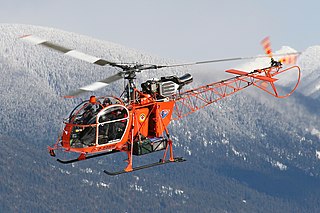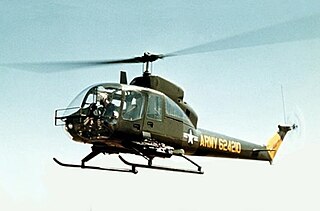
The Boeing Vertol CH-46 Sea Knight is an American medium-lift tandem-rotor transport helicopter powered by twin turboshaft engines. It was designed by Vertol and manufactured by Boeing Vertol following Vertol's acquisition by Boeing.

The Kamov Ka-25 is a naval helicopter, developed for the Soviet Navy in the USSR from 1958.

The Mil Mi-8 is a medium twin-turbine helicopter, originally designed by the Soviet Union in the 1960s and introduced into the Soviet Air Force in 1968. It is now produced by Russia. In addition to its most common role as a transport helicopter, the Mi-8 is also used as an airborne command post, armed gunship, and reconnaissance platform.

The Mil Mi-2 is a small, three rotor blade Soviet-designed multi-purpose helicopter developed by the Mil Moscow Helicopter Plant designed in the early 1960s, and produced exclusively by WSK "PZL-Świdnik" in Poland. Nearly 5500 were made by the time production stopped in 1999, and it remains in service globally.

The Kamov Ka-27 is a military helicopter developed for the Soviet Navy, and currently in service in various countries including Russia, Ukraine, Vietnam, China, South Korea, and India. Variants include the Ka-29 assault transport, the Ka-28 downgraded export version, and the Ka-32 for civilian use.

The Aérospatiale Alouette II is a French light helicopter originally manufactured by Sud Aviation and later Aérospatiale. It was the first production helicopter powered by a gas turbine engine instead of the heavier conventional piston powerplant.

The Mil Mi-38 is a transport helicopter designed by Mil Moscow Helicopter Plant and being developed by Kazan Helicopters. Originally intended as a replacement for the Mil Mi-8 and the Mi-17, it is being marketed in both military and civil versions. It flew for the first time on 22 December 2003 and was certified on 30 December 2015.

The Mil Mi-17 is a Soviet-designed Russian military helicopter family introduced in 1975 (Mi-8M), continuing in production as of 2021 at two factories, in Kazan and Ulan-Ude. It is known as the Mi-8M series in Russian service. The helicopter is mostly used as a medium twin-turbine transport helicopter, as well as an armed gunship version.

The Mil Mi-14 is a Soviet shore-based nuclear-capable amphibious anti-submarine helicopter derived from the earlier Mi-8.

The Mil Mi-6, given the article number izdeliye 50 and company designation V-6, is a Soviet/Russian heavy transport helicopter that was designed by the Mil design bureau. It was built in large numbers for both military and civil use and was the largest helicopter in production until the Mil Mi-26 was put in production in 1980.

The Mil Mi-1 was a Soviet three- or four-seat light utility helicopter. It was the first Soviet helicopter to enter serial production. It is powered by one 575 hp (429 kW) Ivchenko AI-26V radial piston engine. It entered service in 1950 and was first seen on the 1951 Soviet Aviation Day, Tushino and was produced for 16 years. More than 1,000 were built in the USSR and 1,594 in Poland, as SM-1.

The Kamov Ka-26 is a Soviet light utility helicopter with co-axial rotors.

The Mil Mi-26 is a Soviet/Russian heavy transport helicopter. Its product code is Izdeliye 90. Operated by both military and civilian operators, it is the largest helicopter to have gone into serial production.

The Aérospatiale SA 315B Lama is a French single-engined helicopter. It combines the lighter Aérospatiale Alouette II airframe with Alouette III components and powerplant. The Lama possesses exceptional high altitude performance.

The Hiller OH-23 Raven is two or three-place, military light observation helicopter based on the Hiller Model 360. The Model 360 was designated by the company as the UH-12, which was first flown in 1948. Initially it was two-place helicopter powered by a piston engine that entered service in the late 1940s, it went on to be a popular military and civilian light helicopter in the late 20th century. A Hiller UH-12 was the first helicopter to make a transcontinental flight across the USA, in 1949. It served in the Korean War with U.N. forces and also in Vietnam. It was an important early helicopter and was widely used internationally, and in U.K service it was called the Hiller HT Mk 1 and Mk 2; and the U.S. Navy also used it as the HTE-1 for training. It was sold commercially as the UH-12, though some military operators used the company designation. Some later models were designed for turbine power, and version with 4-seats was also sold. In Canada, UH-13E served the military as the CH-112 Nomad.

The Hughes TH-55 Osage is a piston-powered light training helicopter produced for the United States Army. It was also produced as the Model 269 family of light utility helicopters, some of which were marketed as the Model 300. The Model 300C was produced and further developed by Schweizer after 1983.

The Westland WS-51 Dragonfly helicopter was built by Westland Aircraft and was an Anglicised licence-built version of the American Sikorsky S-51.

The Harbin Z-9 is a Chinese military utility helicopter with civilian variants. It is a licensed variant of the French Eurocopter AS365 Dauphin, and is manufactured by Harbin Aircraft Manufacturing Corporation.

The Fairchild Hiller FH-1100 is a single-engine turbine, single two-bladed rotor, light helicopter that was designed and produced by the American aircraft manufacturer Fairchild Hiller in the 1960s.

The Harbin Z-5 is a Chinese variant of the Soviet Mil Mi-4 piston powered helicopter. Before its discontinuation from service, it was produced in Harbin, China.

























